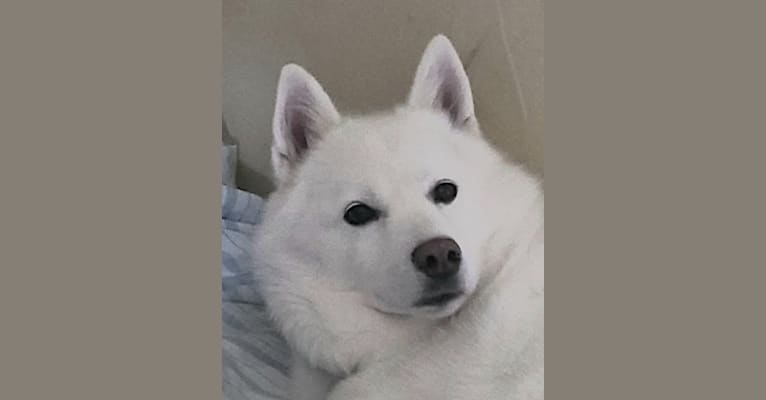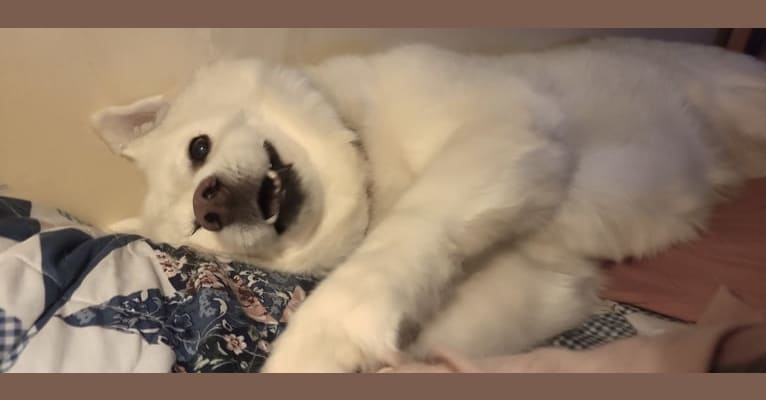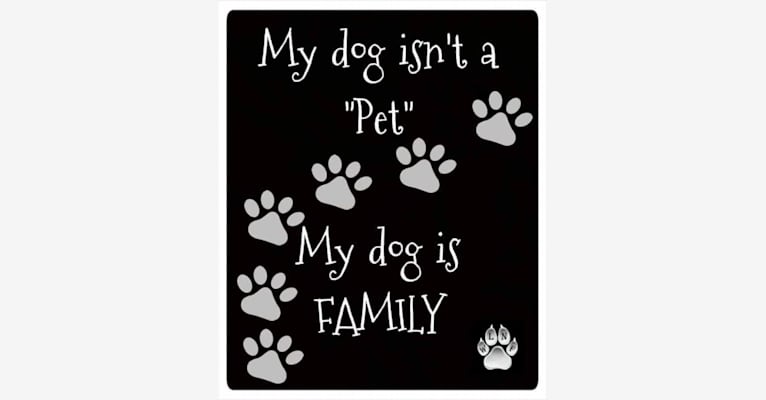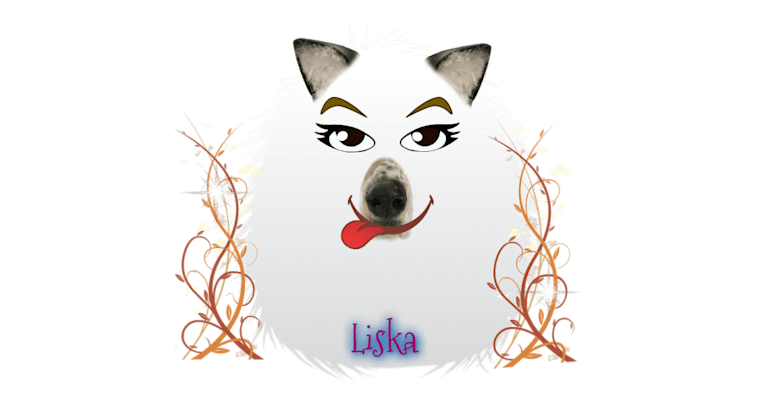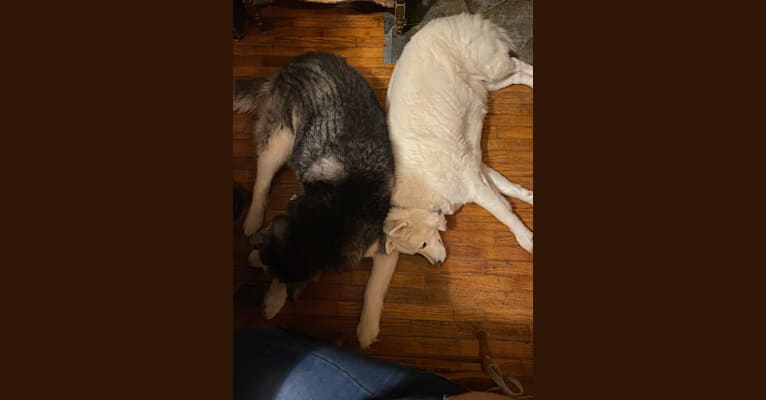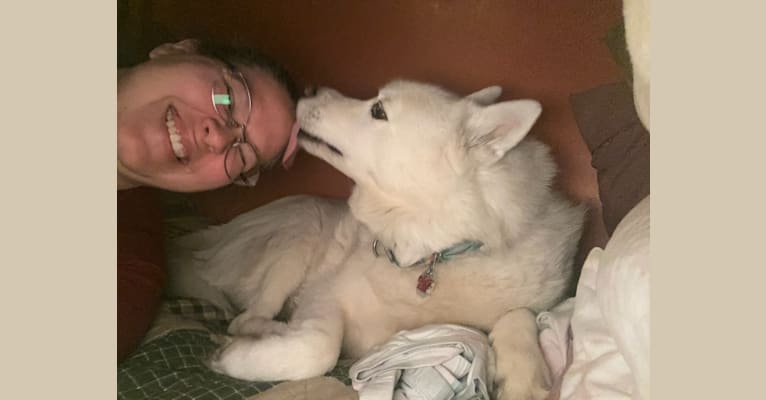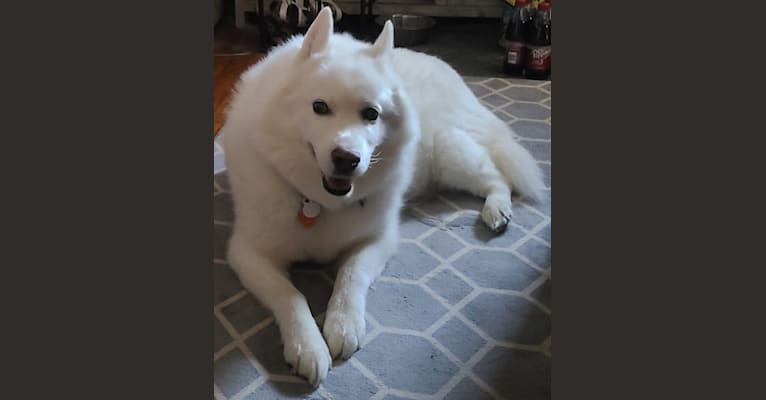-
Hello !! My Name is LISKA. -
One of my camping trips -
Being silly -
Some of my mom's other dogs before I came along. -
I'm loved -
How my mom feels about me -
Just a silly picture of me someone sent my mom -
In the camper -
This was Liska's best friend Draco, He is no longer with us -RIP -
My oldest daughter and Liska -
“She's a cuddler”
Place of Birth
New York, USA
Current Location
Lyons, New York, USA
From
Lyons, New York, USA
This dog has been viewed and been given 3 wags
Documents
Genetic Breed Result
Liska
Mixed Ancestry
71.5% Siberian Husky
15.3% German Shepherd Dog
7.1% American Eskimo Dog
6.1% Alaskan Malamute

Siberian Husky
Bred initially in Northern Siberia, the Siberian Husky is a medium-sized working dog who is quick and light on their feet. Their moderately compact and well furred body, erect ears and brush tail suggest their Northern heritage. Huskies are very active and energetic and are known for being long distance sled dogs.
Learn More

German Shepherd Dog
German Shepherds are confident, courageous dogs with a keen sense of smell and notable intelligence. These are active working dogs who excel at many canine sports and tasks -- they are true utility dogs! Their versatility combined with their loyal companionship has them consistently listed as one of the most popular breeds in the United States.
Learn More

American Eskimo Dog
American Eskimo Dogs belong to the spitz family and they actually came from Germany. They got their start in American circuses due to their intelligence. Today, Eskies make wonderful family pets.
Learn More

Alaskan Malamute
The Alaskan Malamute is a large, fluffy spitz breed recognized as being one of the most ancient breeds of dogs. The forebears to the modern Malamute crossed the Bering Strait with their owners over 4,000 years ago. Their size, thick coat, and work drive make them ideal dogs for pulling sleds, but they also make amicable companions.
Learn More
Dig into your dog’s mix
From energy to appetite, from herding to health — it’s amazing how much you can learn about your dog with just a cheek swab. What will you find out?
Get your test
Start a conversation! Message this dog’s humans.
Genetic stats
Dogs Like Liska

Discover dogs who share a similar breed mix to Liska. A higher score means the two dogs have more of their breed mix in common. A score of 100% means they share the exact same breed mix!
Click or tap on a pic to learn more about each dog and see an in-depth comparison of their DNA, breeds, and more.
DNA Breed Origins
Explore
Here’s what Liska’s family tree may have looked like.






























Dig into your dog’s mix
From energy to appetite, from herding to health — it’s amazing how much you can learn about your dog with just a cheek swab. What will you find out?
Get your test
Explore
Health Summary
Good news!
Liska is not at increased risk for the genetic health conditions that Embark tests.
Breed-Relevant Genetic Conditions
Multiple Drug Sensitivity
Identified in German Shepherd Dogs
Variant not detected
Factor VII Deficiency
Identified in Alaskan Malamutes
Variant not detected
Hemophilia A
Identified in German Shepherd Dogs
Variant not detected
Hemophilia A
Identified in German Shepherd Dogs
Variant not detected
Thrombopathia
Identified in American Eskimo Dogs
Variant not detected
Canine Leukocyte Adhesion Deficiency Type III, CLAD III
Identified in German Shepherd Dogs
Variant not detected
Platelet Factor X Receptor Deficiency, Scott Syndrome
Identified in German Shepherd Dogs
Variant not detected
Progressive Retinal Atrophy, prcd
Identified in American Eskimo Dogs
Variant not detected
X-Linked Progressive Retinal Atrophy 1, XL-PRA1
Identified in Siberian Huskies
Variant not detected
Day Blindness
Identified in Alaskan Malamutes and Siberian Huskies
Variant not detected
Day Blindness
Identified in German Shepherd Dogs
Variant not detected
Primary Lens Luxation
Identified in American Eskimo Dogs
Variant not detected
Urate Kidney & Bladder Stones
Identified in German Shepherd Dogs
Variant not detected
Primary Ciliary Dyskinesia, PCD
Identified in Alaskan Malamutes
Variant not detected
Anhidrotic Ectodermal Dysplasia
Identified in German Shepherd Dogs
Variant not detected
Renal Cystadenocarcinoma and Nodular Dermatofibrosis
Identified in German Shepherd Dogs
Variant not detected
Mucopolysaccharidosis Type VII, Sly Syndrome, MPS VII
Identified in German Shepherd Dogs
Variant not detected
GM1 Gangliosidosis
Identified in Siberian Huskies
Variant not detected
Degenerative Myelopathy, DM
Identified in American Eskimo Dogs, German Shepherd Dogs, and more
Variant not detected
Alaskan Malamute Polyneuropathy, AMPN
Identified in Alaskan Malamutes
Variant not detected
Ichthyosis
Identified in German Shepherd Dogs
Variant not detected
Additional Genetic Conditions
Explore
Traits
Explore the genetics behind your dog’s appearance and size.

Base Coat Color
Genetic Result: EE
Gene: Melanocortin Receptor 1 (MC1R)
This gene helps determine whether a dog can produce dark (black or brown) hairs or lighter yellow or red hairs. Any result except for ee means that the dog can produce dark hairs. An ee result means that the dog does not produce dark hairs and will have lighter yellow or red hairs all over its entire body.
The overall MC1R genetic result is influenced by more subloci than those presented in this section. Additional MC1R subloci results can be found under the Coat Color Modifiers > Facial Fur Pattern section below.
If a dog has an ee result, then the fur’s actual shade can range from a deep copper to white - the exact color cannot be predicted solely from this result and will depend on other genetic factors, including the red pigment intensity test.
More information: http://www.doggenetics.co.uk/masks.html
Genetic Result: NN
Gene: HPS3
Dogs with the coco genotype will produce dark brown pigment instead of black in both their hair and skin. Dogs with the Nco genotype will produce black pigment, but can pass the co variant on to their puppies. Dogs that have the coco genotype as well as the bb genotype at the B locus are generally a lighter brown than dogs that have the Bb or BB genotypes at the B locus.
The co variant and the dark brown "cocoa" coat color have only been documented in French Bulldogs. Dogs with the cocoa coat color are sometimes born with light brown coats that darken as they reach maturity.
More information: http://www.doggenetics.co.uk/liver.html#cocoa
Genetic Result: Dilute Red Pigmentation
Intensity refers to the concentration of red pigment in the coat. Dogs with more densely concentrated (intense) pigment will be a deeper red, while dogs with less concentrated (dilute) pigment will be tan, yellow, cream, or white. Five locations in the dog genome explain approximately 70% of red pigmentation intensity variation across all dogs. Because the locations we test may not directly cause differences in red pigmentation intensity, we consider this to be a linkage test.
One of the genes that influences pigment intensity in dogs, TYR, is also responsible for intensity variation in domestic mice, cats, cattle, rabbits, and llamas. In dogs and humans, more genes are involved.
Genetic Result: Bb
Gene: Tyrosinase Related Protein 1 (TYRP1)
This gene helps determine whether a dog produces brown or black pigments. Dogs with a bb result produce brown pigment instead of black in both their hair and skin, while dogs with a Bb or BB result produce black pigment. Dogs that have ee at the E (Extension) Locus and bb at this B (Brown) Locus are likely to have red or cream coats and brown noses, eye rims, and footpads, which is sometimes referred to as "Dudley Nose" in Labrador Retrievers.
“Liver” or “chocolate” is the preferred color term for brown in most breeds; in the Doberman Pinscher it is referred to as “red”.
More information: http://www.doggenetics.co.uk/liver.html
Genetic Result: DD
Gene: Melanophilin (MLPH)
This gene helps determine whether a dog has lighter “diluted” pigment. A dog with a Dd or DD result will not be dilute. A dog with a dd result will have all their black or brown pigment lightened (“diluted”) to gray or light brown, and may lighten red pigment to cream. This affects their fur, skin, and sometimes eye color. The D locus result that we report is determined by three different genetic variants that can work together to cause diluted pigmentation. These are the common d allele, also known as “d1”, and the less common alleles known as “d2” and “d3”. Dogs with two d alleles, regardless of which variant, are typically dilute.
There are many breed-specific names for these dilute colors, such as “blue”, “charcoal”, “fawn”, “silver”, and “Isabella”. Dilute dogs, especially in certain breeds, have a higher incidence of Color Dilution Alopecia which causes hair loss in some patches.
More information: http://www.doggenetics.co.uk/dilutes.html

Coat Color Modifiers
Genetic Result: kyky
Gene: Canine Beta-Defensin 103 (CBD103)
This gene helps determine whether the dog has a black coat. Dogs with a kyky result will show a coat color pattern based on the result they have at the A (Agouti) Locus. A KBKB or KBky result means the dog is dominant black, which overrides the fur pattern that would otherwise be determined by the A (Agouti) Locus. These dogs will usually have solid black or brown coats, or if they have ee at the E (Extension) Locus then red/cream coats, regardless of their result at the A (Agouti) Locus. Dogs who test as KBky may be brindle rather than black or brown.
Even if a dog is “dominant black” several other genes could still impact the dog’s fur and cause other patterns, such as white spotting.
More information: http://www.doggenetics.co.uk/black.htm
Genetic Result: awat
Gene: Agouti Signalling Protein (ASIP)
This gene is responsible for causing different coat patterns. It only affects the fur of dogs that do not have ee at the E (Extension) Locus and do have kyky at the K (Dominant Black) Locus. It controls switching between black and red pigment in hair cells, which means that it can cause a dog to have hairs that have sections of black and sections of red/cream, or hairs with different colors on different parts of the dog’s body. Sable or Fawn dogs have a mostly or entirely red coat with some interspersed black hairs. Agouti or Wolf Sable dogs have red hairs with black tips, mostly on their head and back. Black and tan dogs are mostly black or brown with lighter patches on their cheeks, eyebrows, chest, and legs. Recessive black dogs have solid-colored black or brown coats.
The ASIP gene causes interesting coat patterns in many other species of animals as well as dogs.
More information: http://www.doggenetics.co.uk/tan.html
Genetic Result: EE
Gene: Melanocortin Receptor 1 (MC1R)
This gene determines whether a dog can have dark hair and can give it a black “mask” or “widow’s peak,” unless the dog has overriding coat color genetic factors. Dogs with one or two copies of Em in their result may have a mask, which is dark facial fur as seen in the German Shepherd Dog and Pug. Dogs with no Em in their result but one or two copies of the Eg, Ea, or Eh variants can instead have a "widow's peak", which is dark forehead fur.
The "widow’s peak" is seen in the Afghan Hound and Borzoi, and is called either “grizzle” or “domino.”
In the absence of Em, dogs with the Eg variant can have a “widow’s peak” phenotype. In the absence of both Em and E variants, dogs with the Ea or Eh variants can express the “widow’s peak” phenotype. Additionally, a dog with any combination of two of the Eg, Ea, or Eh variants (example: EgEa) is also expected to express the grizzle phenotype.
More information: http://www.doggenetics.co.uk/masks.html
Genetic Result: NI
Gene: RALY
The "Saddle Tan" pattern causes the black hairs to recede into a "saddle" shape on the back, leaving a tan face, legs, and belly, as a dog ages. The Saddle Tan pattern is characteristic of breeds like the Corgi, Beagle, and German Shepherd. Dogs that have the II genotype at this locus are more likely to be mostly black with tan points on the eyebrows, muzzle, and legs as commonly seen in the Doberman Pinscher and the Rottweiler. This gene modifies the A Locus at allele, so dogs that do not express at are not influenced by this gene.
The Saddle Tan pattern is characteristic of breeds like the Corgi, Beagle, and German Shepherd.
Genetic Result: SS
Gene: MITF
This gene is responsible for most of the white spotting observed in dogs. Dogs with a result of spsp will have a nearly white coat or large patches of white in their coat. Dogs with a result of Ssp will have more limited white spotting that is breed-dependent. A result of SS means that a dog likely has no white or minimal white in their coat. The S Locus does not explain all white spotting patterns in dogs and other causes are currently being researched. Some dogs may have small amounts of white on the paws, chest, face, or tail regardless of their result at this gene.
Any dog can have white spotting regardless of coat color. The colored sections of the coat will reflect the dog’s other genetic coat color results.
More information: http://www.doggenetics.co.uk/white.htm
Genetic Result: rr
Gene: USH2A
This gene, along with the S Locus, regulates whether a dog will have roaning. Dogs with at least one copy of R will likely have roaning on otherwise uniformly unpigmented white areas created by the S Locus. Roan may not be visible if white spotting is limited to small areas, such as the paws, chest, face, or tail. The extent of roaning varies from uniform roaning to non-uniform roaning, and patchy, non-uniform roaning may look similar to ticking. Roan does not appear in white areas created by other genes, such as a combination of the E Locus and I Locus (for example, Samoyeds). The roan pattern can appear with or without ticking.
Roan, tick, and Dalmatians' spots become visible a few weeks after birth. The R Locus is probably involved in the development of Dalmatians' spots.
More information: http://www.doggenetics.co.uk/ticking.html
Genetic Result: mm
Gene: PMEL
This gene is responsible for mottled or patchy coat color in some dogs. Dogs with an M*m result are likely to appear merle or could be "non-expressing" merle, meaning that the merle pattern is very subtle or not at all evident in their coat. Dogs with an M*M* result are likely to have merle or double merle coat patterning. Dogs with an mm result are unlikely to have a merle coat pattern.
Merle coat patterning is common to several dog breeds including the Australian Shepherd, Catahoula Leopard Dog, and Shetland Sheepdog.
More information: http://www.doggenetics.co.uk/merle.html
Genetic Result: hh
Gene: PSMB
This gene, along with the M Locus, determines whether a dog will have harlequin patterning. This pattern is recognized in Great Danes and causes dogs to have a white coat with patches of darker pigment. A dog with an Hh result will be harlequin if they are also M*m or M*M* at the M Locus and are not ee at the E locus. Dogs with a result of hh will not be harlequin.
While many harlequin dogs are white with black patches, some dogs have grey, sable, or brindle patches of color, depending on their genotypes at other coat color genes.
More information: http://www.doggenetics.co.uk/harlequin.html

Other Coat Traits
Genetic Result: II
Gene: RSPO2
This gene is responsible for “furnishings”, which is another name for the mustache, beard, and eyebrows that are characteristic of breeds like the Schnauzer, Scottish Terrier, and Wire Haired Dachshund. A dog with an FF or FI result is likely to have furnishings. A dog with an II result will not have furnishings. We measure this result using a linkage test.
In breeds that are expected to have furnishings, dogs without furnishings are the exception - this is sometimes called an “improper coat”.
Genetic Result: ShSh
Gene: FGF5
This gene affects hair length in many species, including cats, dogs, mice, and humans. In dogs, an Lh allele confers a long, silky hair coat across many breeds, including Yorkshire Terriers, Cocker Spaniels, and Golden Retrievers. An ShSh or ShLh result is likely to mean a shorter coat, like in the Boxer or the American Staffordshire Terrier. The coat length determined by FGF5, as reported by us, is influenced by four genetic variants that work together to promote long hair.
The most common of these is the Lh1 variant (G/T, CanFam3.1, chr32, g.4509367) and the less common ones are Lh2 (C/T, CanFam3.1, chr32, g.4528639), Lh3 (16bp deletion, CanFam3.1, chr32, g.4528616), and Lh4 (GG insertion, CanFam3.1, chr32, g.4528621). The FGF5_Lh1 variant is found across many dog breeds. The less common variants, FGF5_Lh2 have been found in the Akita, Samoyed, and Siberian Husky, FGF5_Lh3 have been found in the Eurasier, and FGF5_Lh4 have been found in the Afghan Hound, Eurasier, and French Bulldog.
The Lh alleles have a recessive mode of inheritance, meaning that two copies of the Lh alleles are required to have long hair. The presence of two Lh alleles at any of these FGF5 loci is expected to result in long hair. One copy each of Lh1 and Lh2 have been found in Samoyeds, one copy each of Lh1 and Lh3 have been found in Eurasiers and one copy each of Lh1 and Lh4 have been found in Afghan Hounds and Eurasiers.
In certain breeds, such as Pembroke Welsh Corgi and French Bulldog, the long coat is described as “fluffy.”
Genetic Result: CC
Gene: MC5R
This gene affects how much a dog sheds. Dogs with furnishings or wire-haired coats tend to be low shedders regardless of their result for this gene. In other dogs, a CC or CT result indicates heavy or seasonal shedding, like many Labradors and German Shepherd Dogs. Dogs with a TT result tend to be lighter shedders, like Boxers, Shih Tzus and Chihuahuas.
Genetic Result: CC
Gene: KRT71
For dogs with long fur, dogs with a TT or CT result will likely have a wavy or curly coat like the coat of Poodles and Bichon Frises. Dogs with a CC result will likely have a straight coat—unless the dog has a "Likely Furnished" result for the Furnishings trait, since this can also make the coat more curly.
Dogs with short coats may have straight coats, whatever result they have for this gene.
Genetic Result: NN
Gene: FOXI3
This gene can cause hairlessness over most of the body as well as changes in tooth shape and number. This particular gene occurs in Peruvian Inca Orchid, Xoloitzcuintli (Mexican Hairless), and Chinese Crested; other hairless breeds are due to different genes. Dogs with the NDup result are likely to be hairless while dogs with the NN result are likely to have a normal coat. We measure this result using a linkage test.
The DupDup result has never been observed, suggesting that dogs with that genotype cannot survive to birth.
Genetic Result: NN
Gene: SGK3
This gene is responsible for Hairlessness in the American Hairless Terrier. Dogs with the DD result are likely to be hairless. Dogs with the ND genotype will have a normal coat, but can pass the D variant on to their offspring.
Genetic Result: NN
Gene: SLC45A2
This gene causes oculocutaneous albinism (OCA), also known as Doberman Z Factor Albinism. Dogs with a DD result will have OCA. Effects include severely reduced or absent pigment in the eyes, skin, and hair, and sometimes vision problems due to lack of eye pigment (which helps direct and absorb ambient light) and are prone to sunburn. Dogs with a ND result will not be affected, but can pass the mutation on to their offspring. We measure this result using a linkage test.
This particular mutation can be traced back to a single white Doberman Pinscher born in 1976, and it has only been observed in dogs descended from this individual.

Other Body Features
Genetic Result: CC
Gene: BMP3
This gene affects muzzle length. A dog with a AC or CC result is likely to have a medium-length muzzle like a Staffordshire Terrier or Labrador, or a long muzzle like a Whippet or Collie. A dog with a AA result is likely to have a short muzzle, like an English Bulldog, Pug, or Pekingese.
At least five different genes affect snout length in dogs, with BMP3 being the only one with a known causal mutation. For example, the muzzle length of some breeds, including the long-snouted Scottish Terrier or the short-snouted Japanese Chin, appear to be caused by other genes. This means your dog may have a long or short snout due to other genetic factors. Embark is working to figure out what these might be.
Genetic Result: CC
Gene: T
This is one of the genes that can cause a short bobtail. Most dogs have a CC result and a long tail. Dogs with a CG result are likely to have a bobtail, which is an unusually short or absent tail. This can be seen in many “natural bobtail” breeds including the Pembroke Welsh Corgi, the Australian Shepherd, and the Brittany Spaniel. Dogs with GG genotypes have not been observed, suggesting that dogs with such a result do not survive to birth.
While certain lineages of Boston Terrier, English Bulldog, Rottweiler, Miniature Schnauzer, Cavalier King Charles Spaniel, and Parson Russell Terrier, and Dobermans are born with a natural bobtail, it is not always caused by this gene. This suggests that other unknown genetic effects can also lead to a natural bobtail.
Genetic Result: CC
Gene: LMBR1
This is one of the genes that can cause hind dew claws, which are extra, nonfunctional digits located midway between a dog's paw and hock. Dogs with a CT or TT result have about a 50% chance of having hind dewclaws. Hind dew claws can also be caused by other, still unknown, genes. Embark is working to figure those out.
Hind dew claws are commonly found in certain breeds such as the Saint Bernard.
Genetic Result: CC
Gene: ACSL4
This gene can cause heavy muscling along the back and trunk in characteristically "bulky" large-breed dogs including the Saint Bernard, Bernese Mountain Dog, Greater Swiss Mountain Dog, and Rottweiler. A dog with the TT result is likely to have heavy muscling. Leaner-shaped large breed dogs like the Great Dane, Irish Wolfhound, and Scottish Deerhound generally have a CC result. The TC result also indicates likely normal muscling.
This gene does not seem to affect muscling in small or even mid-sized dog breeds with lots of back muscling, including the American Staffordshire Terrier, Boston Terrier, and the English Bulldog.
Genetic Result: NN
Gene: ALX4
This gene is associated with blue eyes in Arctic breeds like Siberian Husky as well as tri-colored (non-merle) Australian Shepherds. Dogs with a DupDup or NDup result are more likely to have blue eyes, although some dogs may have only one blue eye or may not have blue eyes at all; nevertheless, they can still pass blue eyes to their offspring. Dogs with a NN result may have blue eyes due to other factors, such as merle or white spotting. We measure this result using a linkage test.
Embark researchers discovered this gene by studying data from dogs like yours. Who knows what we will be able to discover next? Answer the questions on our research surveys to contribute to future discoveries!

Body Size
Genetic Result: NN
Gene: IGF1
This is one of several genes that influence the size of a dog. A result of II for this gene is associated with smaller body size. A result of NN is associated with larger body size.
Genetic Result: GG
Gene: IGFR1
This is one of several genes that influence the size of a dog. A result of AA for this gene is associated with smaller body size. A result of GG is associated with larger body size.
Genetic Result: TT
Gene: STC2
This is one of several genes that influence the size of a dog. A result of AA for this gene is associated with smaller body size. A result of TT is associated with larger body size.
Genetic Result: GG
Gene: GHR - E191K
This is one of several genes that influence the size of a dog. A result of AA for this gene is associated with smaller body size. A result of GG is associated with larger body size.
Genetic Result: CC
Gene: GHR - P177L
This is one of several genes that influence the size of a dog. A result of TT for this gene is associated with smaller body size. A result of CC is associated with larger body size.

Performance
Genetic Result: GG
Gene: EPAS1
This gene causes dogs to be especially tolerant of low oxygen environments, such as those found at high elevations. Dogs with a AA or GA result will be less susceptible to "altitude sickness."
This gene was originally identified in breeds from high altitude areas such as the Tibetan Mastiff.
Genetic Result: NN
Gene: POMC
This gene influences eating behavior. An ND or DD result would predict higher food motivation compared to NN result, increasing the likelihood to eat excessively, have higher body fat percentage, and be more prone to obesity. Read more about the genetics of POMC, and learn how you can contribute to research, in our blog post. We measure this result using a linkage test.
POMC is actually short for "proopiomelanocortin," and is a large protein that is broken up into several smaller proteins that have biological activity. The smaller proteins generated from POMC control, among other things, distribution of pigment to the hair and skin cells, appetite, and energy expenditure.
Dig into your dog’s mix
From energy to appetite, from herding to health — it’s amazing how much you can learn about your dog with just a cheek swab. What will you find out?
Get your test
Explore
Through Liska’s mitochondrial DNA we can trace her mother’s ancestry back to where dogs and people first became friends. This map helps you visualize the routes that her ancestors took to your home. Their story is described below the map.
A1e
A241

A1e
This female lineage likely stems from some of the original Central Asian wolves that were domesticated into modern dogs starting about 15,000 years ago. It seemed to be a fairly rare dog line for most of dog history until the past 300 years, when the lineage seemed to “explode” out and spread quickly. What really separates this group from the pack is its presence in Alaskan village dogs and Samoyeds. It is possible that this was an indigenous lineage brought to the Americas from Siberia when people were first starting to make that trip themselves! We see this lineage pop up in overwhelming numbers of Irish Wolfhounds, and it also occurs frequently in popular large breeds like Bernese Mountain Dogs, Saint Bernards and Great Danes. Shetland Sheepdogs are also common members of this maternal line, and we see it a lot in Boxers, too. Though it may be all mixed up with European dogs thanks to recent breeding events, its origins in the Americas makes it a very exciting lineage for sure!
A241
Part of the large A1e haplogroup, this haplotype occurs most commonly in village dogs up in Alaska.

Irish Wolfhounds are a consistent carrier of A1e.
Dig into your dog’s mix
From energy to appetite, from herding to health — it’s amazing how much you can learn about your dog with just a cheek swab. What will you find out?
Get your test
Explore
The Paternal Haplotype reveals a dog’s deep ancestral lineage, stretching back thousands of years to the original domestication of dogs.
Are you looking for information on the breeds that Liska inherited from her mom and dad? Check out her breed breakdown and family tree.
Paternal Haplotype is determined by looking at a dog’s Y-chromosome—but not all dogs have Y-chromosomes!
Why can’t we show Paternal Haplotype results for female dogs?
All dogs have two sex chromosomes. Female dogs have two X-chromosomes (XX) and male dogs have one X-chromosome and one Y-chromosome (XY). When having offspring, female (XX) dogs always pass an X-chromosome to their puppy. Male (XY) dogs can pass either an X or a Y-chromosome—if the puppy receives an X-chromosome from its father then it will be a female (XX) puppy and if it receives a Y-chromosome then it will be a male (XY) puppy.
As you can see, Y-chromosomes are passed down from a male dog only to its male offspring.
Since Liska is a female (XX) dog, she has no Y-chromosome for us to analyze and determine a paternal haplotype.
Dig into your dog’s mix
From energy to appetite, from herding to health — it’s amazing how much you can learn about your dog with just a cheek swab. What will you find out?
Get your test
